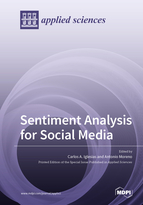Sentiment Analysis for Social Media
A special issue of Applied Sciences (ISSN 2076-3417). This special issue belongs to the section "Computing and Artificial Intelligence".
Deadline for manuscript submissions: closed (30 April 2019) | Viewed by 67277
Special Issue Editors
Interests: multiagent systems; social computing; linked data; natural language processing; affect technology; machine learning
Special Issues, Collections and Topics in MDPI journals
Interests: recommender systems; decision support systems; explainable AI; artificial intelligence
Special Issues, Collections and Topics in MDPI journals
Special Issue Information
Dear Colleagues,
Sentiment analysis technologies enable the automatic analysis of social media and social networks to identify the polarity of posted opinions. These technologies have been extended in the last years to analyze other aspects, such as the stance of a user towards a topic or the users’ emotions, even combining text analytics with other inputs, including multimedia analysis or social network analysis.
This Special Issue “Sentiment Analysis for Social Media” aims to reflect recent developments in sentiment analysis, and to present new advances in sentiment analysis that enable the development of future sentiment analysis and social media monitoring methods. Submissions are expected to focus on both the theoretical aspects and applications of sentiment analysis techniques. New ideas proposing disruptive approaches are also welcome.
Topics of interest include, but are not limited to, the following areas:
- Sentiment and emotion analysis in social media and social networks.
- Semantic models for sentiment analysis.
- Multimodal sentiment analysis.
- Multilingual aspects of sentiment analysis.
- Language resources and tools for sentiment analysis.
- Applications of sentiment analysis.
- Evaluation techniques for sentiment analysis.
We hope this Special Issue works as a roadmap for all developers and users of sentiment analysis.
Dr. Carlos A. Iglesias
Dr. Antonio Moreno
Guest Editors
Manuscript Submission Information
Manuscripts should be submitted online at www.mdpi.com by registering and logging in to this website. Once you are registered, click here to go to the submission form. Manuscripts can be submitted until the deadline. All submissions that pass pre-check are peer-reviewed. Accepted papers will be published continuously in the journal (as soon as accepted) and will be listed together on the special issue website. Research articles, review articles as well as short communications are invited. For planned papers, a title and short abstract (about 100 words) can be sent to the Editorial Office for announcement on this website.
Submitted manuscripts should not have been published previously, nor be under consideration for publication elsewhere (except conference proceedings papers). All manuscripts are thoroughly refereed through a single-blind peer-review process. A guide for authors and other relevant information for submission of manuscripts is available on the Instructions for Authors page. Applied Sciences is an international peer-reviewed open access semimonthly journal published by MDPI.
Please visit the Instructions for Authors page before submitting a manuscript. The Article Processing Charge (APC) for publication in this open access journal is 2400 CHF (Swiss Francs). Submitted papers should be well formatted and use good English. Authors may use MDPI's English editing service prior to publication or during author revisions.







